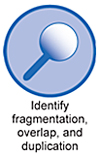An Analyst’s Duplication and Cost Savings Toolkit
For 5 years, our annual reports have identified areas of fragmentation, overlap, and duplication in the federal government, as well as opportunities to achieve cost savings or enhance revenue. We also track how agencies and Congress address these proposed actions. This year, we are releasing a step-by-step guide that can help analysts, federal agencies, and policymakers identify and address fragmented, overlapping, or duplicative programs.
The guide includes tools for both analysts and policymakers, but anyone—including federal, state, and local auditors; researchers; and consultants—can use it to conduct a fragmentation, overlap, and duplication review.
Today we’re focusing on the steps for analysts, shown on the left side of this figure:
Steps for Analysts and Policymakers: Evaluating and Managing Fragmentation, Overlap, and Duplication
(Excerpted from GAO-15-49SP)
4 Steps to Increased Efficiency and Effectiveness
 In this step, analysts should answer these questions:
In this step, analysts should answer these questions:
- Which programs should be evaluated?
- What is the relevant background information about these programs? (e.g., who are the programs’ customers, or, what are the program goals?)
- Are the programs
- fragmented, with functions spread across multiple offices or agencies?
- overlapping with other programs that have similar goals, beneficiaries, or strategies?
- duplicative, providing the same activities to serve the same beneficiaries?
- How are the programs related? (e.g., do programs exchange information, or plan program activities together?)
* * *
Here, analysts should determine whether potential effects in areas such as program implementation, outcomes, and costs are positive or negative. For example,
- a positive effect we found was in domestic food assistance, where overlap among 18 programs better ensured full coverage of potential beneficiaries, who may have different comfort levels with different types of assistance.
- a negative effect, also in domestic food assistance programs, was where overlap among programs resulted in staff at both government agencies and local organizations dedicating time and resources to separately managing the programs, even when a number of them provided comparable benefits to similar groups.
* * *
Next, analysts should determine whether the potential effects are actual effects and assess which programs perform best or are most cost-effective by asking questions, like
- Are agencies implementing programs as intended?
- Do outcomes differ across programs or aspects of programs?
A great place to start is by reviewing existing, relevant, and reliable evaluations of the programs in question. Evaluations can come from the agency, or from organizations like GAO or OMB. If there are none, analysts should consider conducting new program evaluations.
* * *
Regardless of whether effects of fragmentation, overlap, or duplication are positive or negative, analysts should propose options for improvement. For cases with positive effects, analysts could still recommend strategies to help improve efficiency, such as new processes or technology.
To reduce or better manage negative effects, analysts could recommend options such as improving coordination and collaboration, or consolidating, streamlining, or eliminating programs. For example, we found that the military services used a fragmented approach for acquiring combat uniforms, and had not collaborated on joint criteria for uniforms. To minimize fragmentation and reduce costs, we recommended that the military departments pursue partnerships to jointly develop uniforms.
* * *
For each of these steps, analysts should make sure to confirm information with relevant agencies, associations, and subject-matter experts.
To learn more, check out our duplication and cost savings work on our website. You can also check out this page, which has direct links to the specific steps and Tip Sheets and Tools for Analysts.
Comments on GAO’s WatchBlog? Contact blog@gao.gov.









